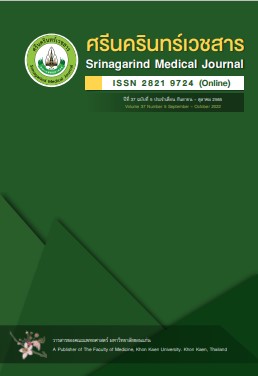ผลของการฝึกการทรงตัวด้วยเครื่องสะท้อนกลับจากแรงกดฝ่าเท้าในผู้ป่วยโรคหลอดเลือดสมอง : การศึกษาแบบสุ่มและมีกลุ่มควบคุม
การทรงตัว กายภาพบำบัด แผ่นรองแรงกดด้วยฝ่าเท้า เครื่องสะท้อนกลับ
คำสำคัญ:
การทรงตัว, ผู้ป่วยโรคหลอดเลือดสมองระยะเรื้อรัง, เครื่องสะท้อนจากแรงกดด้วยฝ่าเท้าบทคัดย่อ
หลักการและวัตถุประสงค์:โรคหลอดเลือดสมองทำให้เกิดความพิการในกลุ่มประชากร ปัจจุบันมีการนำเทคนิคสะท้อนกลับมาใช้ในการฝึกฟื้นฟู การศึกษานี้จึงมีวัตถุประสงค์เพื่อศึกษาผลของการฝึกการทรงตัวด้วยเครื่องสะท้อนกลับด้วยแรงกดที่ฝ่าเท้าในผู้ป่วยโรคหลอดเลือดสมองระยะเรื้อรัง
วิธีการศึกษา: การศึกษานี้เป็นการทดลองแบบสุ่มและมีกลุ่มควบคุมโดยปกปิดสองทาง ในอาสาสมัครโรคหลอดเลือดสมองระยะเรื้อรัง จำนวน 29 ราย โดยใช้วิธีการสุ่มเข้ากลุ่มทดลอง 16 ราย และกลุ่มควบคุม 13 ราย ทั้ง 2 กลุ่มได้รับการฟื้นฟูทางกายภาพบำบัดแบบดั้งเดิม ครั้งละ 45 นาที จำนวน 3 ครั้งต่อสัปดาห์ เป็นเวลา 4 สัปดาห์ กลุ่มทดลองได้รับการฝึกด้วยเครื่องสะท้อนกลับด้วยแรงกดที่ฝ่าเท้า 20 นาทีต่อครั้ง 3 วันต่อสัปดาห์ เป็นระยะเวลา 4 สัปดาห์แล้วตามด้วยการฝึกกายภาพบำบัดแบบดั้งเดิมตัวแปร ในการศึกษาได้แก่ ความสามารถในการทรงตัวประเมินโดย Berg balance scale (BBS) และความเสี่ยงต่อการล้มประเมินโดยTime up and Go test (TUG) โดยประเมินก่อนและหลังได้รับโปรแกรมการรักษา
ผลการศึกษา: พบว่าทั้งสองกลุ่มมีค่า BBS และ TUG เพิ่มขึ้นอย่างมีนัยสำคัญทางสถิติ (p < 0.05) เมื่อเปรียบเทียบระหว่างกลุ่มพบว่าค่า TUG ของกลุ่มทดลอง ต่างกับกลุ่มควบคุมทั้งก่อนและหลังส่วนค่า BBS ของทั้งสองกลุ่มไม่แตกต่างกันทั้งก่อนและหลังการศึกษา
สรุป: การฝึกการทรงตัวด้วยเครื่องสะท้อนกลับจากแรงกดฝ่าเท้า เป็นเวลา 4 สัปดาห์ ทำให้ผู้ป่วยมีความสามารถในทรงตัวดีขึ้นมากกว่าการทำกายภาพบำบัดเพียงอย่างเดียว
เอกสารอ้างอิง
Pound P, Gompertz P, Ebrahim S. A patient-centred study of the consequences of stroke. Clin Rehabil 1998;12:338-47.
Duncan PW, Zorowitz R, Bates B, Choi JY, Glasberg JJ, Graham GD, et al. Management of adult stroke rehabilitation care: a clinical practice guideline. Stroke 2005;36:100-43.
Yates JS, Lai SM, Duncan PW, Studenski S. Falls in community-dwelling stroke survivors: an accumulated impairments model. J Rehabil Res Dev 2002;39:385-94.
Alexander LD, Black SE, Patterson KK, Gao F, Danells CJ, McIlroy WE. Association between gait asymmetry and brain lesion location in stroke patients. Stroke 2009;40:537-44.
Perry J, Garrett M, Gronley J, Mulroy S. Classification of walking handicap in the stroke population. Stroke 1995;26(6):982-9.
Rosner B. Fundamentals of Biostatistics. 8th ed. Boston (MA): Cengage Learning; 2016.
Yen HC, Luh J, Nicolau C. Realiability of lower extremity muscle strength measurement with handle dynamometry in stroke patient patients during the acute phase: a pilot reliability study. Phys Ther Sci 2017;29(2):317.
Hiengkaew V, Jitaree K, Chaiyawat P. Minimal detectable changes of the Berg Balance Scale, Fugl-Meyer Assessment Scale, timed "Up & Go" Test, gait speeds, and 2-minute walk test in individuals with chronic stroke with different degrees of ankle plantarflexor tone. Arch Phys Med Rehabil 2012;93(7):1201-8.
Alghadir A, Al-Eisa E, Anwer S, Sarkar B. Reliability, validity, and responsiveness of three scales for measuring balance in patients with chronic stroke. BMC neurology 2018;18(1):141.
Institute of Geriatric Medicine, Department of Medical Services, Ministry of Public Health Thailand. Mini-Mental State Examination-Thai 2002, 2002.
Duffy L, Gajree S, Langhorne P, Stott DJ, Quinn J. Reliability (Inter-rater agreement) of the barthel index for assessment of stroke survivors systematic review and meta-analysis. Stroke 2013;44:462-8.
Donaghy S, Wass. P. Interrater reliability of the Functional Assessment Measure in a brain injury rehabilitation program. Arch Phys Med Rehabil 1998;79(10):1231-6.
Berg K, Wood-Dauphinee S, Williams JI. The Balance Scale Reliability assessment with elderly residents and patients with an acute stroke. Scand J Rehabil Med 1995;27:27–3.
Stevenson TJ. Detecting change in patients with stroke using the Berg Balance Scale. Aust J Physiother 2001;47:29-38.
Shumway-Cook A, Brauer S, Woollacott M. Predicting the probability for falls in community-dwelling older adults using the time up & go test. Phys Ther 2000;80(9):896-903.
Podsiadlo D, Richardson S. The timed “up & go”: a test of basic functional mobility for frail elderly persons. J Am Geriatr Soc 1991;39:142–8.
Nualnetr N. Principle in physical therapy for neurology patient. Khonkaen: Krunknana vitaya, 2005.
Geiger R, Allen J, O'Keefe J, Hicks R. Balance and mobility following stroke: effects of physical therapy interventions with and without biofeedback/forceplate training. Phys Ther 2001;81(4):995-1005.
Nichols DS. Balance retraining after stroke using force platform biofeedback. Phys Ther 1997;77:553-8.
Winstein C, Gardner ER, McNeal DR, Barto PS, Nicholson DE. Standing balance training: effect on balance and locomotion in hemiparetic adults. Arch Phys Med Rehabil 1989;70(10):755-62.
Sackley CM, Lincoln NB. Single blind randomized controlled trial of visual feedback after stroke: effects on stance symmetry and function. Disabil Rehabil 1997;19(12):536–46.
Dietz V, Muller R, Colombo G. Locomotor activity in spinal man: significance of afferent input from joint and load receptors. Brain 2002;125:2626-34.
Duysens J, Clarac F, Cruse H. Load-regulating mechanisms in gait and posture: comparative aspects. Physiol Rev 2000;80:83-133.
Sinkjaer T, Andersen JB, Ladouceur M, Christensen LO, Nielsen JB. Major role for sensory feedback in soleus EMG activity in the stance phase of walking in man. J Physiol 2000;523 Pt 3:817-27.
van Duijnhoven HJR, Heeren A, Peters MAM, Veerbeek JM, Kwakkel G, Geurts ACH, et all. Effects of exercise therapy on balance capacity in chronic stroke: systematic review and meta-analysis. Stroke 2016;47:2603–10.
Liao W, Lai C, Hsu P, Chen K, Wang C. Different weight shift trainings can improve the balance performance of patients with a chronic stroke. Medicine 2018;97:45(e13207).
Cheng PT, Wu SH, Liaw MY, Wong AM, Tang FT. Symmetrical body-weight distribution training in stroke patients and its effect on fall prevention. Arch Phys Med Rehabil 2001;82:1650–4.
Shumway-Cook A, Anson D, Haller S. Postural sway biofeedback: its effect on reestablishing stance stability in hemiplegic patients. Arch Phys Med Rehabil 1988;69:395–400.
Srivastava A, Taly AB, Gupta A, Kumar S, Murali T. Post-stroke balance training: role of force platform with visual feedback technique. J Neurol Sci 2009;287:89–93.
Feng H, Li C, Liu J, Wang L, Ma J, Li G, et al. Virtual reality rehabilitation vs. conventional physical therapy for improving balance and gait in parkinson's disease patients: a randomized controlled trial. Med Sci Monit 2019;25:4186–92.
ดาวน์โหลด
เผยแพร่แล้ว
รูปแบบการอ้างอิง
ฉบับ
ประเภทบทความ
สัญญาอนุญาต
ลิขสิทธิ์ (c) 2022 ศรีนครินทร์เวชสาร

อนุญาตภายใต้เงื่อนไข Creative Commons Attribution-NonCommercial-NoDerivatives 4.0 International License.




